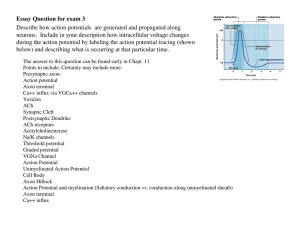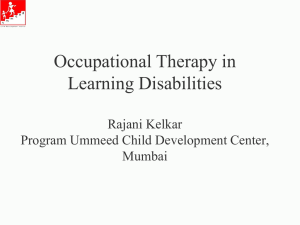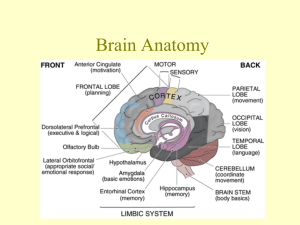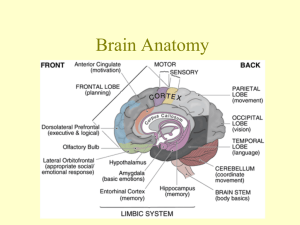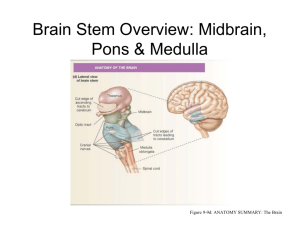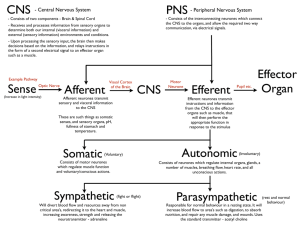CNS pharmacology
advertisement
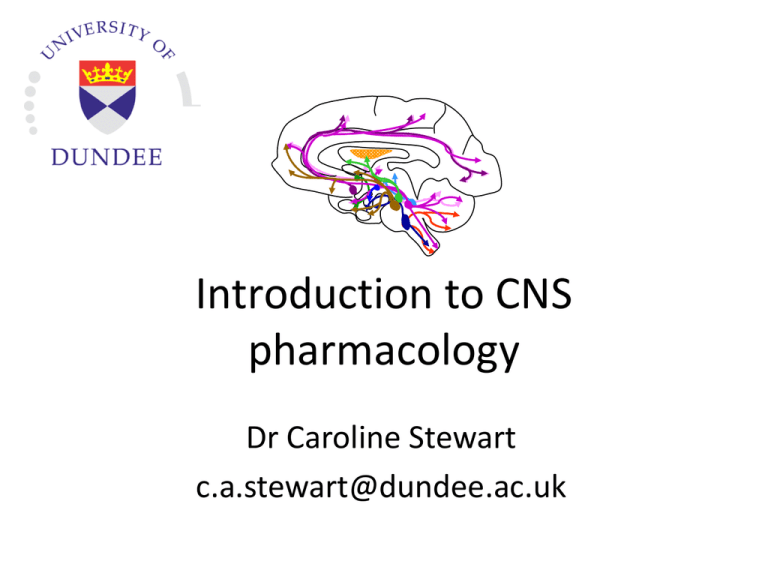
Introduction to CNS pharmacology Dr Caroline Stewart c.a.stewart@dundee.ac.uk Learning Outcomes • List the principal neurotransmitters of the central nervous system. • Be aware of the distribution and function of the major neurotransmitters in the brain. • Describe the processes involved in chemical transmission at central synapses. • Explain the mechanisms by which drugs gain access to the central nervous system. What is the central nervous system? • PNS: – Autonomic • Sympathetic • parasympathetic – Somatic • CNS: – Brain – Spinal cord Function of the CNS • Receive and process information (spinal cord is usually the conduit) • Initiate and maintain appropriate response – physical – emotional Components of the CNS • Neurones • Glial Cells – – – – Astrocytes Oligodendrocytes Ependymal cells Microglia • Extracellular space • Ventricular system (CSF) Organisation of the CNS • Sensory system • Motor system • Limbic system Sensory system Cortex Specific projection Sensory receptor Reticular activating system: Regulates arousal and wakefulness Motor system Motor cortex Corticospinal pathway (pyramidal tract) CNS sensory system Extrapyramidal system (motor coordination and posture) cerebellum basal ganglia vestibular nuclei Sensory receptor Polysynaptic spinal interneurones Anterior horn cell Skeletal muscle Limbic system Processing of sensory information Cortex Limbic system Regulation of emotion and mood Hypothalamus Pituitary Centres regulating autonomic function and links to others via medulla (e.g. BP, HR) Ganglia Cingulate gyrus Anterior nucleus of thalamus Thalamus Para-olfactory area Fornix Mamillary bodies of hypothalamus Hypothalamus Hippocampus Uncus Amygdala Para-hippocampal gyrus The synapse • Transmission of information from one neurone to another Chemical messengers • Neurotransmitter (fast and slow synaptic transmission) • Neuromodulator (diffuse, slower action) • Neurotrophin (long lasting effects on growth and morphology) Identifying neurotransmitters • Localisation • Release • Synaptic mimicry • Synaptic pharmacology Types of neurotransmitter • Small molecules – amino acids (glutamate, GABA) – biogenic amines (ACh, NA, DA, 5-HT) • Neuropeptides – (cholecystokinin, Substance P, enkephalins) • Diffusable gases – nitric oxide • Lipid mediators – (e.g. endocannabinoids) • Neurotrophins – (e.g. nerve growth factor) • Steroids Amino acid neurotransmitters NH2 O • Glutamic acid (glutamate): principal excitatory transmitter in the brain • Gamma amino butyric acid (GABA): main inhibitory transmitter in the brain HO • Widely distributed • Target for general anaesthetics, anti-epileptics, anxiolytics. OH O OH O NH2 Cholinergic system O O N+ • Acetylcholine • Receptors: muscarinic and nicotinic Motor control Learning and memory Attentional processes NH2 HO Noradrenergic system • Noradrenaline/norepinephrine • Receptors: and -adrenoceptors OH OH Arousal, emotion Dopaminergic system • Dopamine • Receptors:D1 and D2 family HO HO NH2 Motor control Motivation/reward Prolactin release Serotonergic (5HT) system HO • Serotonin (5-hydroxytryptamine) • Receptors: many subtypes 5HT1, 5HT2, 5HT3 mood, sleep, feeding behaviour and sensory perception Analgesia Neuropeptides • Synthesised as large precursor polypeptides • Packaged in large dense core vesicles • Substance P and opioid peptides found in spinal cord and higher brain centres • Play a role in perception of pain Synaptic transmission (chemical) Nerve terminal Metabolites e.g. decarboxylase Precursor nT Presynaptic receptor nT nT nT Postsynaptic receptor Transporter Targets for drug action • Ion channels • Receptors • Enzymes • Transport proteins Blood brain barrier Brain receives 2530% of cardiac output but capillaries have no fenestration (holes) Entry of drugs into brain • In general, lipid soluble drugs get in, water soluble drugs kept out • Brain penetration predicted by oil/water partition coefficient (relative solubility in organic solvent compared to water) • Specific transporters or carrier molecules present • In some areas of the brain it is more “leaky” • area postrema of medulla • chemoreceptor trigger zone in hypothalamus Classification of drugs • By structure e.g. benzodiazepine • By pharmacological action e.g. monoamine oxidase inhibitor • By clinical action e.g. antipsychotic The End



